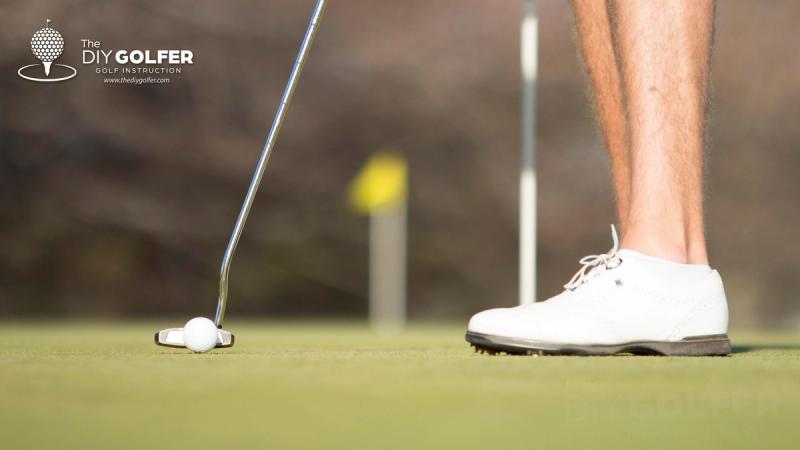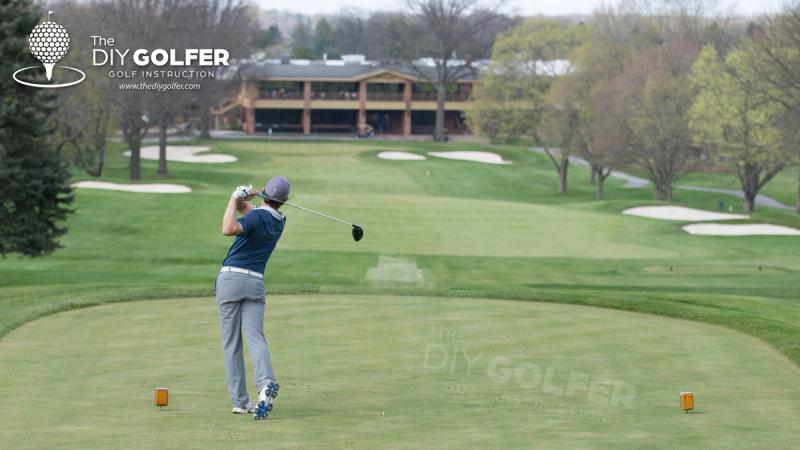Table of Contents

Last updated Nov 09, 2023
My Putting Process: Routine, Green Reading, and More
Becoming a great putter is a function of your equipment, green reading skills, practice, pre-shot routine, and how you translate it to the course.


Written By: Zach Gollwitzer
Posted in: Putting Fundamentals
If you have read anything from this site before, you probably know that I am a rather systematic and analytical golfer. I have systems and routines for every part of my game, which help to simplify and focus my attention to the factors that have the biggest impact on my scores.
In addition, there are a few posts here on the blog that cover various putting strategies and tools that I use during practice, but nothing that encompasses everything that goes into my putting process. This post is meant to encapsulate all those previous posts into a (hopefully) coherent putting system that you may be able to take bits and pieces from. All golfers have a unique way of doing things, so by no means am I putting forth a system that should be followed by everyone. I simply hope to give a basic structure for those a bit lost on the greens, which can be modified, added to, or followed verbatim.
The Components of Putting
The easiest way to explain my entire putting process is by splitting up the greater topic of "putting" into small, definable categories. All are important, and involve different methods of implementing them:
- Equipment - What putter are you using? What grips have you been successful with?
- Green reading - What is your method for reading greens?
- Practicing - What things do you practice, and how? What kind of technique do you have?
- Routine - What do you do before and during every putt? Are you consistent with it?
- Performing - When you've got a 10 footer to win your weekend match, what is going through your mind?
Throughout the post, I will be going through each category, and explaining my general thinking and methods for each.
Equipment
Before you can make anything, you've got to find a putter that works for you. Now, you may not be a Ben Crenshaw who found a putter (Wilson 8802) that he liked, and used it for the majority of his career (he even nicknamed it "Little Ben"). Instead, you could be someone like Jim Furyk who played 2009 with a Scotty Cameron Del Mar, 2010 with a Scotty Cameron Studio Select Newport, an Odyssey Backstryke Sabertooth sometime in 2010, shot a 58 and 59 with an Odyssey Versa #1, and who knows what he used in the other 20 years that aren't documented online!!
As you can see, not everyone falls in love with one putter, although it isn't recommended that you switch every week.
I fall somewhere in between Jim Furyk and Ben Crenshaw. I have used several putters throughout my career, but eventually have settled in with a style that I haven't changed from for over 6 years now, and don't plan on changing in the future. I have come to like the Odyssey #7 style, and currently carry both an Odyssey White Ice #7 and Odyssey Pro #7.
As far as grips go, I have switched quite frequently over my golfing career. It is nice to get something new in my hands once in a while. Despite this, there are a few grips that I consistently fall back on when the putting goes south, which include the SuperStroke Flatso 3.0, and the Lamkin E.B.L. 3Gen white grip. I have tried several other grips, but always find myself throwing one of these two on either of my Odysseys when the putts aren't dropping.
When looking for a putter, there are several things to consider, and instead of writing them out here, I suggest reading my post on how to find a putter that works for your game. This will take you through many of the considerations that I have learned to make over the years.
Practicing
I placed this section before green reading because your green reading is largely dependent on your alignment and stroke. If you can't successfully start the putt off on the intended line, then you will NEVER become good at reading greens. This is not an opinion, but a fact. If your golf ball starts off in varying directions each time, then it will be impossible to train your mind to read greens correctly.
In order to ensure that I am getting the ball started on the correct line, I work with just a few training aids and drills:
- The Putting Tutor - I spend AT LEAST 10 minutes on this thing EVERY SINGLE PRACTICE SESSION. Why? Because it works, and it trains my eyes and my body to set up correctly to the putt, and get the putt started on the correct line. Yes, when you first purchase and training with this, you WILL be frustrated. Most golfers have no idea where they are aimed, and this device will let you know! For more information on how I use this device, refer to my post on the Putting tutor.
- The Putting Arc - When my stroke becomes a bit wobbly, I will take several practice strokes on this thing. I have found that it is quite difficult to use while hitting a real putt, but definitely helpful for achieving the feeling of a proper stroke.
- 18 Hole Drill - This one is simple. Pick 18 putts over 40 feet, and go through your entire routine on every putt. I don't leave the putting green until I have two-putted every single putt or better, but you can set your own goals depending on skill level. This helps me with lag putting and simulates realistic practice.
It sounds quite simple, but above covers 99% of what I do during putting practice. Sure, there are hundreds of little putting games that you can use, but I have found these three exercises the most effective.
Green Reading
Let me start by acknowledging the fact that much of your green reading success will come from experience, learning to control your speed better, and determining what you risk tolerance on the greens are. I'll touch briefly on each of these, because they are all so important to getting the right read.
As said in the previous section, green reading is nearly impossible when you cannot start the ball on-line consistently. If you are still struggling with that aspect of putting, I would put much less emphasize on your green reading for the time being.
For those that have been around the game a bit longer and who show some sort of consistency in their putting, I would like to cover some of the basics of green reading.
Speed Control
Believe it or not, all of your green reading is going to be based on the speed at which you hit putts into the hole. Although nobody can be perfect, most experienced golfers will fall into one of two categories:
- Die Putters (Jack Nicklaus)
- Aggressive/Charge Putters (Arnold Palmer)
In other words, you've got the guys who like to see the ball fall in the cup with a small amount of speed while playing for maximum break((For beginners, you must realize that the harder you hit a putt, the less it is going to break)), or the guys who like seeing the ball banging into the back of the cup.
Personally, I am a "die putter" because I do not enjoy grinding over 3 footers all day. If you don't mind knocking in 3-footers time and time again, then you might like the second method.
I mention these two types of putters because your green reading depends on which type you are. If you are a die putter like me, you will (in most cases) probably enjoy faster greens, and will probably read putts with more break than other golfers. Regardless of which type you are, it is important to learn to consistently hit putts with the same relative speed. Your green reading will never improve if you are charging your putts in the hole half of the time, and dying them in the other half of the time. Now obviously, there are exceptions to this. If you have an uphill 6 footer, you aren't going to die it into the hole, while at the same time, you aren't going to charge a downhill 10 footer in the back of the cup. I am simply saying that as a golfer, it is in your best interest to attempt to maintain some sort of consistency with how fast you are putting the ball into the hole.
For example, if you have completely flat putts for the first 5 holes, you will want to roll all 5 of these putts in with the same speed.
Personally, unless I have a make-able putt (15 feet or less) up a hill, I imagine my putts trickling over the front edge of the cup.
Improving your green reading
Although your ability to start putts online (as with the Putting Tutor) and your speed control are the main factors in reading putts, there are ways to improve your green reading. I suggest reading the following three posts in order for more insight on this:
- Are you a linear or non-linear putter?
- Should you line up your golf ball?
- Should you use Aimpoint Express for green reading?
Routine
As I preach here over and over again, you are only as good as your routine. You can be great at reading greens, great at starting the ball on line, and great with your speed control on the practice green, but if you don't have a reliable routine that you can trust on the course, any ounce of added pressure will cause some unexpected results.
Although the definition of a putting routine can vary from golfer to golfer, it is important that whatever you define as your "putting routine," you repeat OVER and OVER again. By the time you get on the golf course, your putting routine should be so automatic that all you are thinking about is your line and your speed of the putt. The LAST thing you want is to be worrying about how many practice strokes you are taking, how to get yourself lined up to the putt, etc.
Below is a video of the routine of one of the greatest putters to ever play on tour:
Although Brad doesn't show his process of green reading (which is usually considered part of your pre-putt routine), you get the gist. If you watch him on t.v., he will go through this EXACT same routine EVERY TIME.
Think of your pre-putt routine (whatever you decide on) in terms of driving a car. When you first start out driving, much of your focus and attention is on what you are doing. Once you improve your driving skills and repeat the process over and over again, you get to the point where driving becomes subconscious. Now, instead of focusing on the gas pedal, the brake, and what all the signs on the road mean, you are drinking coffee, talking on the phone, and simultaneously navigating to your destination.
We want our pre-putt routine to become subconscious, just like driving a car. Now obviously you probably shouldn't try and drink coffee while putting, but you get the point. You don't want to be thinking about your feet, your grip, or your alignments, but rather on your destination.
My Putting Routine
Although I have marginally tweaked my routine many times over the years, it has ultimately stayed structurally consistent. I have listed out the specific steps of my routine below:
- Mark my ball with a coin
- Read the putt from behind the ball (coin), and figure out where I want the ball to enter the hole (see my post on linear vs. non-linear putters)
- If I have a downhill putt, I often will go and read the putt from behind the hole. ((Think about reading a putt like reading a book. When you read a book, you generally will hold it in front of you at a slight upward angle. As an experiment, try tilting the book away from you (where the bottom edge of the book is higher than the top edge), and reading it. As you can see, it is much harder to read the words clearly. This same concept applies to reading greens. When the putt is downhill, you often have to go behind the hole to properly read it, because reading a downhill putt from behind the ball is like reading a book with the words slanted away from you.))
- Place the ball down, and stand behind the putt
- Take one deep breathe, wipe the face of my putter (in case there is any sand/grass on it), and walk into the putt
- Line my right foot up with the ball, and line the putter face with my right hand, and then once I have the putter face aimed, I get into my full stance and take my full grip.((I do not take any practice strokes, because I feel that they just distract me from my putt. There is no rule on this. Taking practice strokes is totally up to personal preference, although I only recommend them if you feel that they are genuinely helping you feel the putt. If you are just taking practice strokes because someone told you to, then you may want to remove them from your routine.))
- Look up once, look back at the ball and make small adjustments for comfort.
- Look up twice, look back at the ball, small forward press, and then pull the trigger
- Keep my head down for at least 1 second, and hold my putter in the finish position
I know all of this sounds a bit complicated, but all 8 of these steps happen subconsciously thanks to hours and hours of work on the practice green. This routine is my saving grace when I have a high pressure putt to make!
Developing your pre-putt routine
Although it is entirely up to you, make sure you include the following elements in your routine:
- Some sort of green reading method
- A method for getting aligned properly
- A trigger for your stroke (could be a forward press, holding your breathe, hovering the putter, etc.)
Performing
Thus far in this post, I have covered (what I believe to be) the fundamentals of a solid putting game. If a golfer spends his/her time applying the knowledge gleaned from above, they are bound to improve.
But there is one missing piece to our puzzle, and without it, we will never become proficient on the greens.
That missing piece is the performance factor.
Your entire putting game could look awesome on the practice green, but if you can't make a 5 footer to win a $10 bet, then what's the point of even practicing?
Although much of this last component comes with experience, I believe there are two key ingredients:
- A solid routine (as discussed above)
- A quiet mind
The first part of this recipe is quite straightforward. Any golfer can develop and master a pre-shot routine.
The second one has quite a few grey areas...
What do I mean by a "quiet mind??"
I am talking about that little voice in your head that won't shut up on the golf course.
You know, the voice that keeps saying "don't 3-putt," or "get it to the hole," or "I'll look so dumb if I miss this 3-footer."
This voice is the difference between an average putter and a great putter. The average putter succumbs to the demands of this voice, while the great putter silences it. Unfortunately, I do not have a sure-fire method for silencing this voice, because every golfer handles it differently. What I can do is briefly explain some of the techniques that I have used to silence this inner critic and heckler.
Personally, my method for silencing the mind begins with a meditation practice every single morning. In my opinion, this is the ultimate mind control tool. Sure, you can take the common advice of forcing yourself to "think positively," but this requires a ton of mental energy; something that a golfer needs to conserve throughout the round.
Instead of trying to manufacture positive thoughts for 4 hours straight, my method for overcoming that internal heckler is to simply focus on my breathe. Every time negative thoughts arise on the greens (or anywhere on the course for that matter), I simply catch myself, take 3-6 deep breathes (focusing on the rising and the falling of my abdomen), and then refocus on my putt.
This method has worked quite well over the years, and I highly suggest giving it a try.
Many golfers struggle to implement this method because it is so simple. They believe that golf requires some "magical thought process," while in reality, the pros making the clutch 10 footers on Sunday are doing it from a quiet mind. Of course, like all golfers, these professionals have negative thoughts while on the greens, but instead of listening to these thoughts, engaging with these thoughts, and falling victim to these thoughts, they simply brush them off and forget about them.
To truly grasp the mindset that I am talking about here, let us imagine that we are watching cars go by on a busy street. As the cars pass, you acknowledge them, but they are soon off in the distance; never to be seen again. Now, imagine that these cars are your thoughts. Instead of trying to run after them, just let them drive by.
This is the essence of "getting out of your own way." Many golfers have the potential to shoot low scores, but they have an extremely hard time achieving a "quiet mind."
I wish I could give step-by-step instructions on how to quiet the mind on the golf course, but I truly cannot. That is your job.
Although I can't give you the "secret," I hope that I have gotten you one step closer. Now, it is your job to practice.
Summary
Throughout this post, we have discussed everything that I have learned over my time as a golfer. I'm surely no Jack Nicklaus or Tiger Woods, but many of the techniques and suggestions above have allowed my putter to come alive on a consistent basis. I used to walk out there wondering if I was going to make putts, but now that I have implemented everything that I have discussed above, I no longer have this worry. Sure, I might get out there and struggle on the greens, but I KNOW that at some point in the round, my putter is going to start working.
I hope after reading this post you can do the same (or better!).






